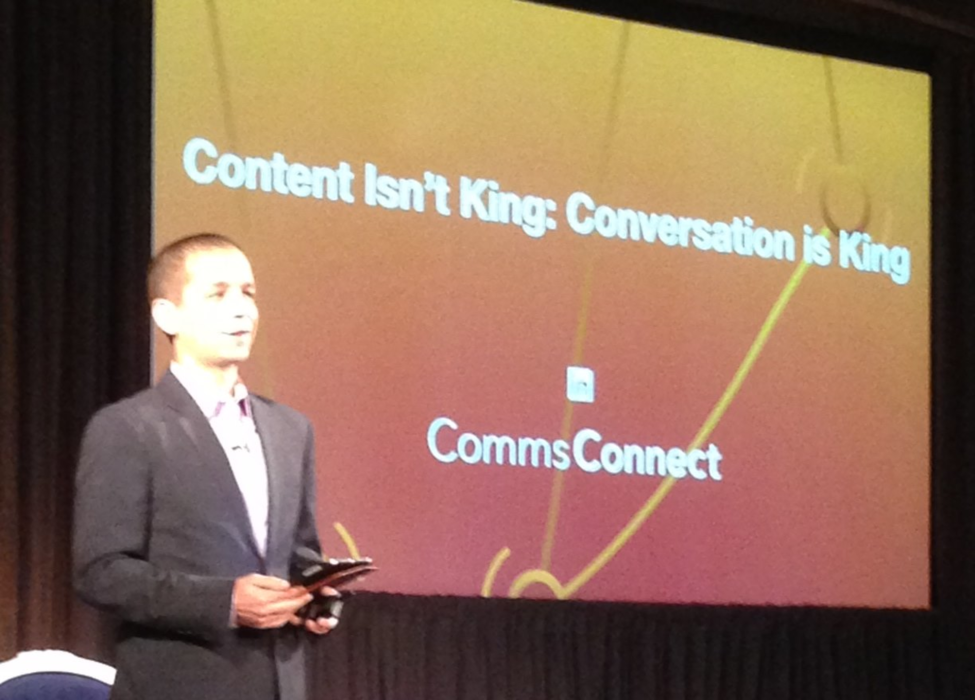At LinkedIn’s inaugural CommsConnect event in San Francisco, executive editor Dan Roth listed several guidelines for LinkedIn success, most of which flew in the face of conventional PR wisdom.
A lot of PR pros look at LinkedIn as the ultimate content marketing platform, especially since it opened its publishing feature to all its users. However, Roth’s talk was about how it was actually conversations, and not tightly controlled, manufactured content that was a true driver of success on LinkedIn. Roth illustrated four winning principles of people who successfully used LinkedIn’s blog posting capabilities to enhance both their personal and company’s brand:
Data gives you guidelines, but it can’t tell you what to write
In an era of Big Data, Roth said content marketers and communications pros were under more pressure to use stats and analytics to inform their decisions and tailor their content around it. However, he cautioned against creating content and LinkedIn posts that relied purely on data, saying that while analytics were great for shaping a strategy, they shouldn’t actually dictate what the content is. “Netflix recommending movie titles based on user profiles is an example of data, but it’s really the content in a show like House of Cards that bind the user to the Netflix brand,” said Roth.
Measure outcomes differently
For content publishers, metrics such as clicks, shares and views are the expected measures of success, but Roth encouraged PR pros to evaluate what the blog post achieved in terms of the conversation it started. “You need to ask ‘What were the comments like? What was the conversation like? What did it lead to?”
Roth gave the example of Target CMO Jeff Jones who published a controversial post on LinkedIn where he was brutally honest about the company’s failures and culture. The post received over 300,000 views, but more importantly it had 550 comments. While many of those comments were critical of Jones and Target, a lot of them were supportive and had recommendations for how Target could win consumers back after its data-breach debacle. “I don’t know if that was a genius marketing move or if Jeff just wanted to bare his soul,” said Roth. “But it doesn’t matter, because in the end, that post fundamentally changed the conversation.”
Give up ownership of the story
Another scary thing for PR pros to hear is to embrace the unknown when it comes to telling a brand’s story. Roth said most professionals who publish on LinkedIn are terrified, editing and re-editing what they are going to say for fear of either offending people or doing something to hurt the brand. However, he says writers are always thrilled once they press that publish button. “The only thing scarier than publishing content is that no one reacts to it,” said Roth. “It’s always better to be heard and talked about.”
People use LinkedIn to build their personal brand as well as their company’s brand
There’s no anonymity on LinkedIn, and that’s why any activity on the platform by a user ultimately affects their personal brand. Additionally, since people on LinkedIn are usually there in a professional capacity, all their activity reflects on the company they work for. This is something comms pros should embrace, despite it being a little scary to let non-traditional communicators speak about the brand. “Instead of a company having one voice that no one is listening to, you now have dozens of voices getting heard everywhere,” said Roth. By encouraging employees to share their personal experiences at the place they work, their company becomes a real, approachable brand that people can care about, rather than just another corporate entity. “Ultimately your brand is a story your employees tell,” Roth said. “The more you can help them, the better off you’ll be.”
Want more of The Hub? Follow us on Twitter, like us on Facebook, and add us on Google +








